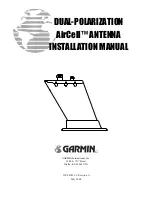
5.4. Grounding
The lightning and overvoltage protection system example, designed in accordance with regulation CSN
EN 62305.
1.
Where possible the antenna should be located in an LPZ 0B protection zone with the use of a
local or artificial air termination device for protection against direct lightning strikes.
2.
When meeting conditions for ensuring electrical insulation (distance from the lightning conductor)
in accordance with article 6.3, it is not recommended to ground the load-bearing structure and
antenna to the external air termination network. Ground should be connected to the protective
system of the internal LV wiring or grounded internal structures using a CYA 6 mm
2
bonding con-
ductor , see Fig. 5.61, “Grounding installation 1”
3.
If it is not possible to set up conditions of electrical insulation in accordance with article 6.3 we re-
commend connecting the load-bearing structure at roof level to the external air termination network
via an 8mm diameter FeZn conductor and shielding the data cable before entry to the building
with a grounding kit and CYA 6 mm
2
conductor to the bonding bus, and if not already set up then
also to the external air termination network, see Fig. 5.62, “Grounding installation 2”
4.
If there is not an external LPS on the building we recommend routing lightning current through an
8mm FeZn conductor to a common grounding system, or to a separate grounding electrode with
a ground resistance up to 10 Ω.
5.
For limiting the overvoltage transferred over the data cable and into the building we recommend
fitting surge protection at the interface between zones LPZ 0 and LPZ 1 connected via a CYA 4
mm
2
conductor to the same grounding point as the antenna or the antenna mast.
6.
We recommend protecting the PoE power supply from overvoltage on the LV side with suitable
class D surge protection.
53
© RACOM s.r.o. – RAy Microwave Link
Installation
















































